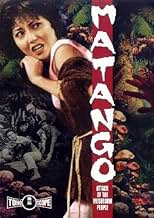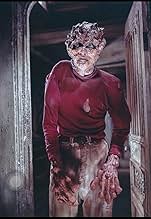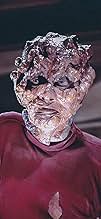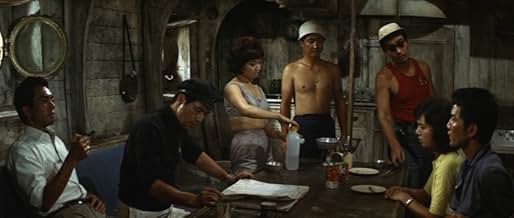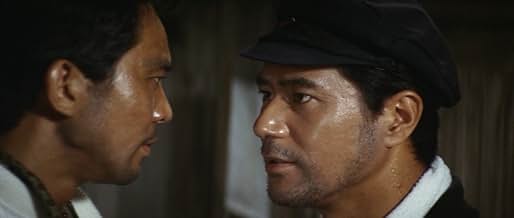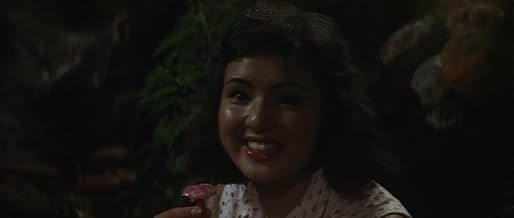IMDb RATING
6.4/10
3.8K
YOUR RATING
Shipwrecked survivors slowly transform into mushrooms.Shipwrecked survivors slowly transform into mushrooms.Shipwrecked survivors slowly transform into mushrooms.
Takuzô Kumagai
- Doctor
- (as Jirô Kumagai)
Featured reviews
When I first saw this film on a local late-night horror movie show, it was the late 1960s and our family hadn't yet purchased a color TV. Growing up with films and TV shows produced and viewed in B&W made me sensitive to the unique qualities of this medium, particularly the way in which it focuses the viewer's attention on the quality and play of light. It is this element of "Matango" which most impressed methe cold ethereal light of the fog-shrouded forest covered in great lumps of pallid fungus sent a real shiver down my back. Although I had cut my teeth on such midnight horror movies, this one actually stole away my sleep for a couple nights!
Over time I had lost track of this film. The Saturday Night horror show became a thing of the past and no one seemed interested in rebroadcasting these old films. Then very recently, on a lark, I asked our local (independent) video rental place if they had this film in their data base, and Lo! there it was, available on VHS. They ordered it, held it for me, I rented it and prepared to sit down and be scared by it again after a hiatus of over 25 years.
Imagine my surprise to find that the film is in color! In color, it didn't have the same impact at all as it did when I watched it on our B&W TV back home. Quickly, before it got too deep into the story, I changed all the settings on my TV to a nicely balanced black and white, and WOW! There it was, the scariness, the moodiness, the mystery, and the visual subtleties which make it a very nice piece of art.
Really, folksyou gotta see this film in black and white to really appreciate how well it was photographed, lighted, constructed and dressed. This is quite a gem of a film, but one which should have been in black and white to begin with.
Over time I had lost track of this film. The Saturday Night horror show became a thing of the past and no one seemed interested in rebroadcasting these old films. Then very recently, on a lark, I asked our local (independent) video rental place if they had this film in their data base, and Lo! there it was, available on VHS. They ordered it, held it for me, I rented it and prepared to sit down and be scared by it again after a hiatus of over 25 years.
Imagine my surprise to find that the film is in color! In color, it didn't have the same impact at all as it did when I watched it on our B&W TV back home. Quickly, before it got too deep into the story, I changed all the settings on my TV to a nicely balanced black and white, and WOW! There it was, the scariness, the moodiness, the mystery, and the visual subtleties which make it a very nice piece of art.
Really, folksyou gotta see this film in black and white to really appreciate how well it was photographed, lighted, constructed and dressed. This is quite a gem of a film, but one which should have been in black and white to begin with.
If you look around on the Internet you can see that almost all the entries for this movie, are above average and there are probably a million different reasons for that. I think they all have in common that somehow this movie really gets people on a sub-conscious level and represents something.
I remember seeing this movie at various times growing up on the late night horror shows, in Houston, Texas, called "Weird" and "Late Wierd", and then in California on "Creature Features".
There is something about watching this movie about a groups of somewhat related friends who are out on a cruise in their rich friends sailboat, well, actually the exact details escape me, and I am not sure that the English tranlation accurately tells what was supposed to be going on in the original story.
The boat is caught in a storm, and they drift through heavy fog to a deserted island where everything is misty, moist, and fungus ridden. To survive they look for food, and find that people have been to the island before, in fact a large group of people on a freighter ship that has wasted away.
There are some clues on the ship as to what happened, and some strange goings on that stress these "friends" to the breaking point, and their cohesion starts to unravel.
There is just something special about this eerie and fun movie that if I ever see it in DVD format I will pick it up.
I remember seeing this movie at various times growing up on the late night horror shows, in Houston, Texas, called "Weird" and "Late Wierd", and then in California on "Creature Features".
There is something about watching this movie about a groups of somewhat related friends who are out on a cruise in their rich friends sailboat, well, actually the exact details escape me, and I am not sure that the English tranlation accurately tells what was supposed to be going on in the original story.
The boat is caught in a storm, and they drift through heavy fog to a deserted island where everything is misty, moist, and fungus ridden. To survive they look for food, and find that people have been to the island before, in fact a large group of people on a freighter ship that has wasted away.
There are some clues on the ship as to what happened, and some strange goings on that stress these "friends" to the breaking point, and their cohesion starts to unravel.
There is just something special about this eerie and fun movie that if I ever see it in DVD format I will pick it up.
I have noticed that many of the commentators in this forum have stated that this film gave them nightmares. No wonder. This film based on William Hope Hodgson's novel "The Voice in the Night", has a plot that is so bizarre that it could only have been inspired by someone's nightmares. The premise of intelligent fungus luring people to eat them and then the people slowly turn to "mushroom people" is so nightmarishly creepy that I can't imagine that Hodgson (or anyone else) could of dreamed this idea up when he was wide awake.
MATANGO (aka ATTACK OF THE MUSHROOM PEOPLE) is a surprisingly low key atmospheric Japanese horror fantasy. The film is a bit slowly paced at times and too much time is spent on the castaways bickering amongst themselves. There are some elements that I suspect were better developed in the novel. One scene has the two female castaways hearing the voices of dead relatives trying to lure them into the rainforest. This never occurs again and leads nowhere. I'm sure the stuff about nuclear experiments was not in Hodgson's novel. However, the art direction is excellent, the music creepy and the final sequence memorable. Overall, the boys at Toho did a good job.
I don't care what the Medvids think of this film, or the pseudo hip MST3K crowd thinks either, your old pal jim says, see this one.
MATANGO (aka ATTACK OF THE MUSHROOM PEOPLE) is a surprisingly low key atmospheric Japanese horror fantasy. The film is a bit slowly paced at times and too much time is spent on the castaways bickering amongst themselves. There are some elements that I suspect were better developed in the novel. One scene has the two female castaways hearing the voices of dead relatives trying to lure them into the rainforest. This never occurs again and leads nowhere. I'm sure the stuff about nuclear experiments was not in Hodgson's novel. However, the art direction is excellent, the music creepy and the final sequence memorable. Overall, the boys at Toho did a good job.
I don't care what the Medvids think of this film, or the pseudo hip MST3K crowd thinks either, your old pal jim says, see this one.
Toho are mostly known for their dark bleak period pieces and their goofy monster flicks, but every once in a while they delved into something else and Matango is a great example of this.
Well ahead of its time it tells the story of ship wreck survivors trying to make it until help comes, but they don't appear to be alone on the island and tensions are beginning to build.
So okay I admit the concept is daft, the antagonists are a bit silly but lets be honest they aren't a million miles from those in The Last of Us (2013). Despite this they actually do the job quite well and look considerably better than you'd imagine considering this was the early 60's.
The film is a real slow burner and very little of it features the antagonists at all, the majority is the turmoil between survivors but it does this to a passable degree.
Though not everything it could have been there is a lot to be impressed over in Matango and it's a neat little forgotten Toho movie that deserves attention.
The Good:
Looks excellent for its time
Some good ideas
The Bad:
Cast and characters are pretty forgettable
Very slow burn
Things I Learnt From This Movie:
An opportune time to tell a woman you love her for the first time is straight after hitting her
Could easily have had a sequel about killer cheese people
Well ahead of its time it tells the story of ship wreck survivors trying to make it until help comes, but they don't appear to be alone on the island and tensions are beginning to build.
So okay I admit the concept is daft, the antagonists are a bit silly but lets be honest they aren't a million miles from those in The Last of Us (2013). Despite this they actually do the job quite well and look considerably better than you'd imagine considering this was the early 60's.
The film is a real slow burner and very little of it features the antagonists at all, the majority is the turmoil between survivors but it does this to a passable degree.
Though not everything it could have been there is a lot to be impressed over in Matango and it's a neat little forgotten Toho movie that deserves attention.
The Good:
Looks excellent for its time
Some good ideas
The Bad:
Cast and characters are pretty forgettable
Very slow burn
Things I Learnt From This Movie:
An opportune time to tell a woman you love her for the first time is straight after hitting her
Could easily have had a sequel about killer cheese people
MATANGO, directed by Ishiro Honda, is an exceptionally beautiful fantasy film from the mighty Toho. Bastardized for its American release, badly dubbed, retitled ("Attack of the Mushroom People") and afforded very little respect, its recent re-emergence as a special edition DVD confirms its place in the realm of fantastique cinema.
What makes this amazing film so effective is its seductively spare but intelligent screenplay, nightmarish atmosphere, serenely creepy score and stunning special effects. Tonally, it recalls underrated Japanese genre flicks such as "The Mistress in a Cave", "Horror of Malformed Men" and the delightful "Living Skeleton". Like the mushrooms the shipwrecked survivors of a pleasure craft are drawn to, it seduces us with its simple structure, pleasing taste and rich subtext.
The film operates on a number of thematic levels, but Honda's achievement is that he never allows the dense thematics to weigh the very human drama down. Like all classic stories of survival, human greed, envy, love and hunger are the engines of the conflict. The search for a state of being free of responsibility and consequences is the dream driving the conflicted.
It is of curious interest to me that the characters in this "uncharted island" fantasy include a Skipper, a Millionaire, a Professor, a First Mate and a Girl Next Door. Produced before "Gilligan's Island" debuted on American TV, it could surely be argued that this orchestration of characters was a template for Sherwood Schwartz, the creator of "Gilligan's Island".
A palpable sadness permeates the last twenty minutes of MATANGO, a sense of blinding melancholy that elevates it to a dizzying level of achievement.
MATANGO explores how we are all drawn to pleasures that we know may sign our death warrants while daring to suggest that death by pleasure is a demise more preferable to death without love.
Stunning.
What makes this amazing film so effective is its seductively spare but intelligent screenplay, nightmarish atmosphere, serenely creepy score and stunning special effects. Tonally, it recalls underrated Japanese genre flicks such as "The Mistress in a Cave", "Horror of Malformed Men" and the delightful "Living Skeleton". Like the mushrooms the shipwrecked survivors of a pleasure craft are drawn to, it seduces us with its simple structure, pleasing taste and rich subtext.
The film operates on a number of thematic levels, but Honda's achievement is that he never allows the dense thematics to weigh the very human drama down. Like all classic stories of survival, human greed, envy, love and hunger are the engines of the conflict. The search for a state of being free of responsibility and consequences is the dream driving the conflicted.
It is of curious interest to me that the characters in this "uncharted island" fantasy include a Skipper, a Millionaire, a Professor, a First Mate and a Girl Next Door. Produced before "Gilligan's Island" debuted on American TV, it could surely be argued that this orchestration of characters was a template for Sherwood Schwartz, the creator of "Gilligan's Island".
A palpable sadness permeates the last twenty minutes of MATANGO, a sense of blinding melancholy that elevates it to a dizzying level of achievement.
MATANGO explores how we are all drawn to pleasures that we know may sign our death warrants while daring to suggest that death by pleasure is a demise more preferable to death without love.
Stunning.
Did you know
- TriviaThe film was nearly banned in Japan. The makeup some characters wore as they were turning into humanoid mushroom creatures was very similar to how many Japanese people looked after the atomic bombings of Hiroshima and Nagasaki.
- GoofsWhen Kasai shoots at Yoshida and Mami as he chases them off the boat, you can see the bullets ricochet off the ground before he even fires a shot.
- Crazy creditsThe opening credits of the Japanese version are on animated sailboat sails.
- ConnectionsEdited into Gli ultimi giorni dell'umanità (2022)
- How long is Matango?Powered by Alexa
Details
- Release date
- Country of origin
- Language
- Also known as
- Attack of the Mushroom People
- Filming locations
- Production company
- See more company credits at IMDbPro
- Runtime
- 1h 29m(89 min)
- Sound mix
- Aspect ratio
- 2.55 : 1
Contribute to this page
Suggest an edit or add missing content

